Archive for the 'Plums' Category
Our multi-grafted Japanese plum tree is full of plums right now. It’s a very small tree, about 5 feet tall and 4 feet wide. But it has over 100 plums on it. It has the most densely packed fruit of any fruit tree we have. It would benefit from thinning, because the branches can break under the weight of the fruit, but I didn’t bother to thin this year, because the fruit set was not as heavy as last year. The main grafts are the varieties Elephant heart and Laroda, which is the dark purple fruit in the picture below.
The tree also has a graft of Nubiana, which is very small and doesn’t grow much, and Beauty. Most of the Beauty graft broke off two years ago under the weight of a heavy load of fruit. I cut off the remaining branches of Beauty, because I didn’t care for its flavor. The Elephant Heart and Laroda grafts are not self-fruitful, but both have managed to set a lot of fruit two seasons in a row without pollen from Beauty. Pollen from our pluot tree and a neighbor’s plum have probably helped. The Beauty graft was huge and on the verge of taking over the tree. The Elephant Heart and Laroda grafts have grown a lot since Beauty has been gone.
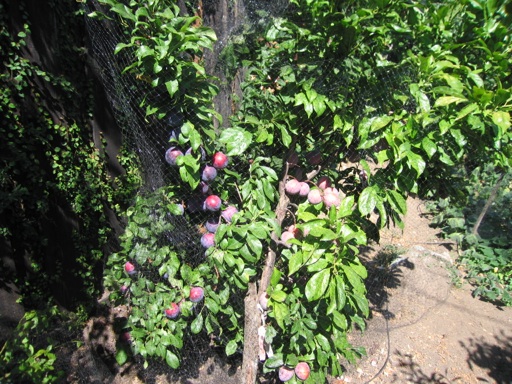
I really enjoy growing sugar pie pumpkins and butternut squash. I have found that they are both easy to grow from seed as long as they get regular water. I planted several groups of seeds last March. The vines are very long now and have set many fruits, even though I haven’t fertilized them. The vines can take up a lot of space, which is why I planted the seeds where the vines can grow in between our fruit trees. I planted them directly in the ground, not in our raised beds, because the vines would just grow out of the beds and across our paths between the beds. Some of the pumpkins have even grown roots directly from the vines into the ground.
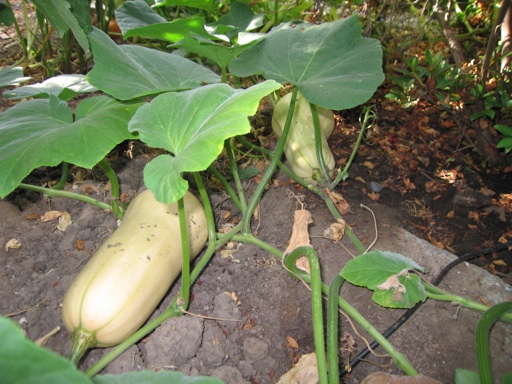
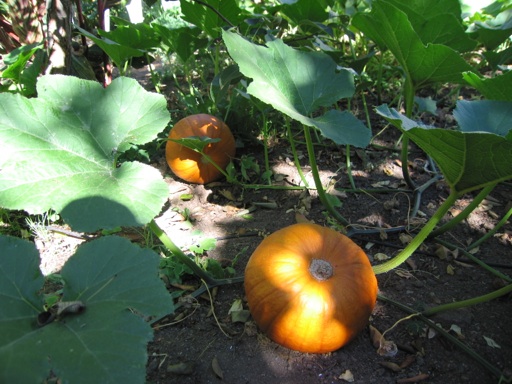
We are also growing Siam Queen (Thai) basil this year. I planted the seeds in pots in our mini-greenhouse in April and transplanted the seedlings into one of our raised beds in May. They only grow in warm weather, and it can get cold in April here. The plants grew slowly at first, but they are now starting to grow more rapidly. Their leaves have a strong scent that is similar to licorice, and their flowers are an attractive purple color. Also, they don’t seem to attract insects.
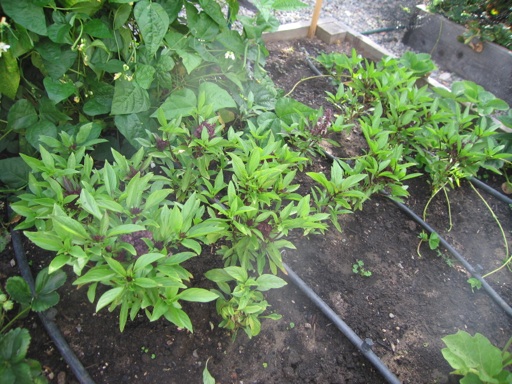
Our purple Dahlias have been full of flowers for several weeks. We are also growing them in raised beds where they get plenty of water and rich composted soil. Unfortunately, they are already getting mildew on their leaves, which happens every year around this time.
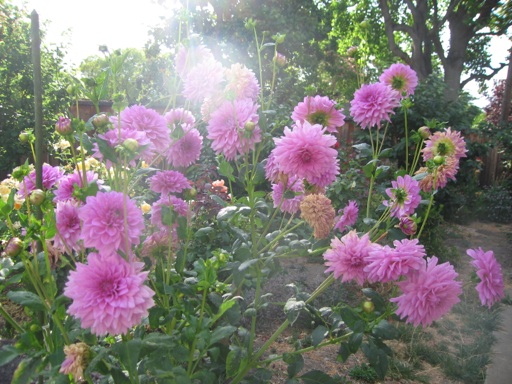
I planted corn seeds in mid-March this year, which is the earliest I have ever planted them. We almost never get frost here after March 1. I planted the peaches and cream variety, and ended up with about 18 plants. I always plant at least 15 corn seeds in a planting to ensure proper pollination. I started harvesting corn ears the first week of this month. They were very tasty.
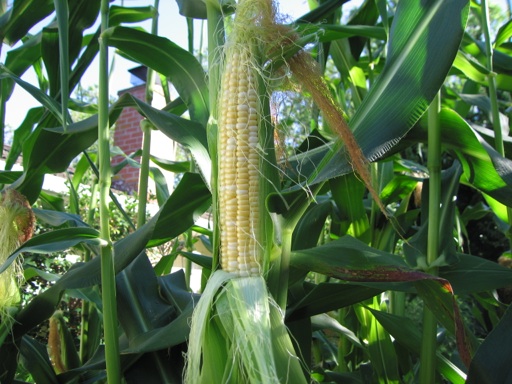
I harvested some of the last ears today. Several of the stalks had two ears, and a few stalks grew outshoots that themselves grew an additional ear of corn. I have more corn in another bed that I planted in June. They should be ready to harvest in October.
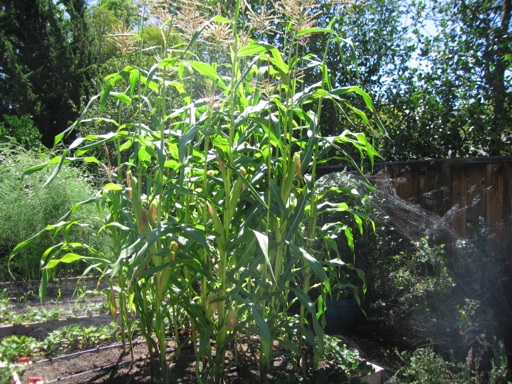
I planted Albion strawberries in pots with potting soil in May. I had not grown this variety previously. I have been picking strawberries from the Albion plants for over a month now, and they have exceeded my expectations. They have been continuously producing very sweet and large berries. They are much sweeter than Chandler, which are on the tart side in our yard. I think I will be planting more Albion strawberries in the future. So far the Albion plants have not produced many runners, unlike our Sequoia strawberries, which are prolifically producing runners right now.
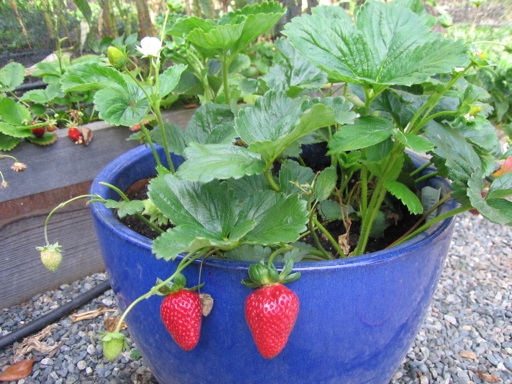
July 26 2014 | Basil and Corn and Dahlias and Plums and Pumpkin and Squash and Strawberries | Comments Off on Mid-summer post
We grow over a dozen different kinds of fruit trees and berries in our yard, including apricots, apples, figs, plums, pears, pluots, peaches, cherries, oranges, blackberries, strawberries, blueberries, and raspberries. Not all of our fruit trees produce fruit every year, and each type of fruit has a limited season. But because we have so many fruits, we typically have fruit to eat from our yard from May through September. Most of the fruit production occurs in our yard in mid-summer, so we have an abundance of fruit in the months of July and August.
This week, I have been harvesting Elephant Heart plums from our multi-grafted plum tree, shown in the photo below. The skin of these plums can be quite sour, at least until the fruit is almost mushy, but the pulp has a nice flavor.
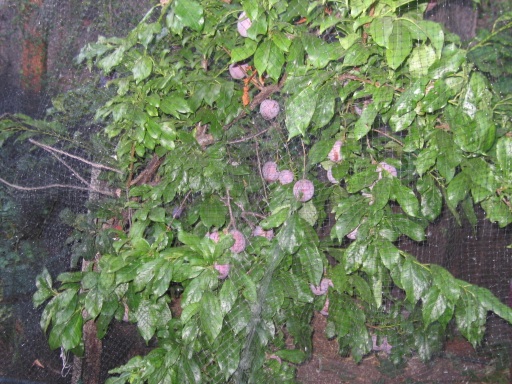
Our small Bartlett pear tree is loaded with at least 100 pears this year (photos of it below). I have picked over 30 pears from it already, but I’ve not eaten any of them yet. Pears are harvested while still green and unripe. They are ready to harvest if the fruit separates from the branch easily when the fruit is lifted by hand into a horizontal position. The pears from this tree have been exquisite in past years. Although, our tree typically only produces pears every other year.
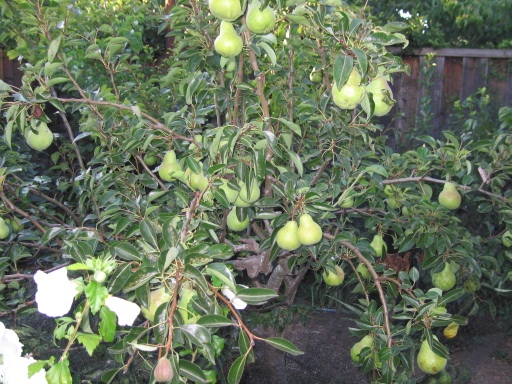
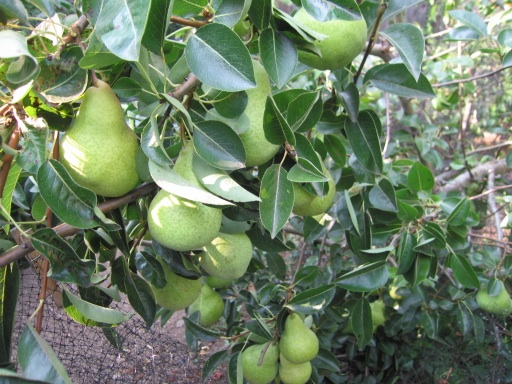
I am also harvesting Flavor King and Dapple Dandy pluots from our multi-grafted pluot tree. The first photo below is Flavor King (purple fruit), and the second photo is Dapple Dandy (pink fruit). I’m supporting the thin branches of this small tree with tomato cages, because there is too much fruit even after I thinned them. Also, the fruit is large (larger than last year’s harvest). I also have to protect them and my other fruit with netting.
Our pluot tree is one of my favorite fruit trees. Its fruits are delicious. Flavor King is perhaps one of the tastiest fruits I have eaten, even though plums in general are not my favorite fruit. Each of the 4 pluot varieties on our tree is unique in terms of its color, flavor, ripening time, and keeping quality. The other two varieties are Flavor Queen and Flavor Supreme. Dapple Dandy is a good variety, because it produces a lot of fruit, and the fruit holds well on the tree for several weeks.
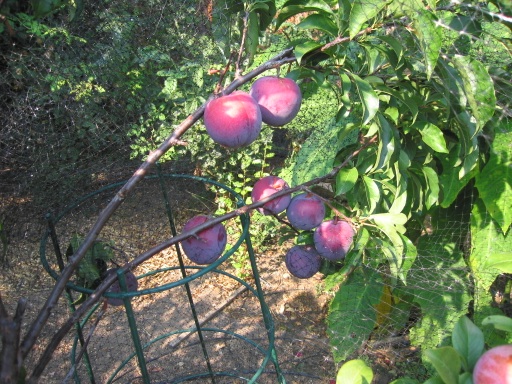
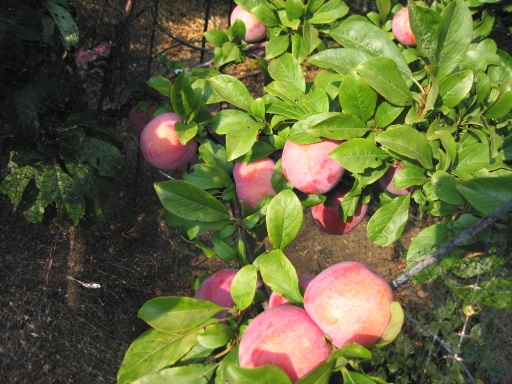
We also have a Caroline red raspberry plant that is growing in a large pot. Its canes are full of luscious looking raspberries right now, as shown in the next photo below. Unfortunately, our raspberries are not edible, because the insides of the berries are full of insect larvae that resemble very small white worms. Nearly all of the berries I have picked in the past week are full of the worms, and it’s not practical to remove them all. Although they may not be harmful if consumed, they are not appetizing.
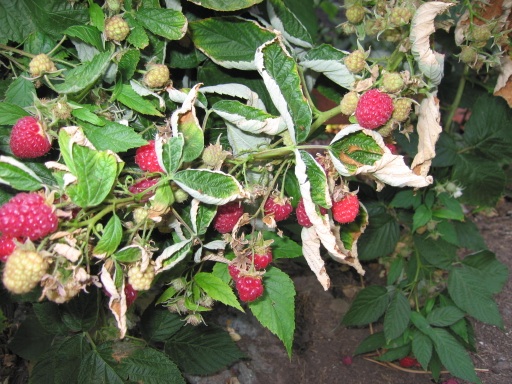
July 29 2013 | Pears and Plums and Pluots and Raspberries | Comments Off on Mid-Summer Fruit
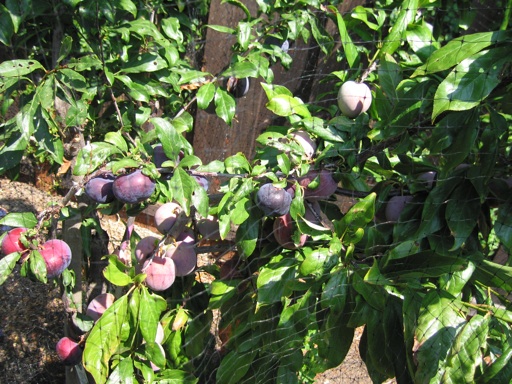
This is a photograph of our 4 variety multi-grafted plum tree taken through bird netting. I just planted this tree last February, and all 4 varieties are already full of plums. The 4 varieties are beauty, nubiana, laroda, and elephant heart. Beauty ripened in June, but its fruits were on the tart side. They really need to be picked when they are very ripe, practically ready to go bad. And even then the skin is still tart. But beauty is a good pollinator for the other three varieties.
Myself, my partner, and my sister all agree that laroda is the best tasting plum of these varieties. Although laroda needs another variety as a pollinator to bear fruit. The flesh of elephant heart has a mild sweet flavor, but the skin is tart. The elephant heart plums are the light purple plums in this picture, and the darker purple plums are nubiana. The nubiana plums are still firm and don’t seem ripe yet despite their coloring, which is strange because nubiana was supposed to ripen before elephant heart, according to the grower.
August 10 2009 | Plums | Comments Off on 4 Variety Plum Tree
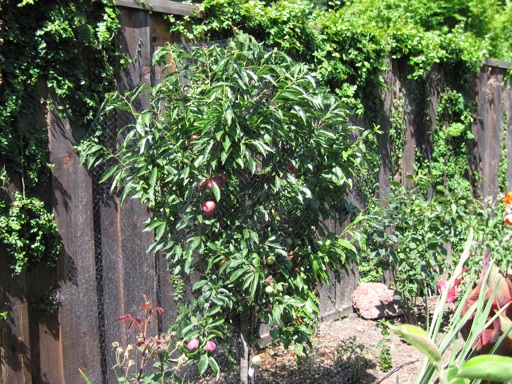
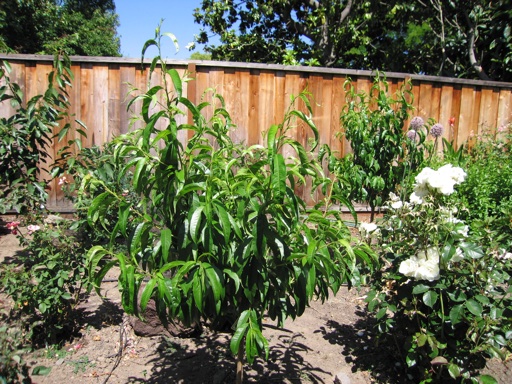
I planted several new fruit trees earlier this year in our yard, including an almond, another peach, a nectarine, a plum, and 2 more cherries. I sometimes hear people say that fruit trees take too many years to produce fruit. For them, I have three words: plums, peaches, and nectarines. All three typically bear fruit by their second year in the ground.
I planted a 4 variety multi-grafted plum tree in February. It already has dozens of plums (see first picture above). Most of the plums are hidden behind the leaves in this picture. The 4 varieties are beauty, nubiana, laroda, and elephant heart. They ripen in June, July, August, and September, respectively, for a 4 four month long plum season. I have already eaten several of the beauty plums, and they are good, with just a little tartness in the skin. Plums produce fruit at a young age. Although my tree wasn’t a new bare root tree when I bought it. It looked like it had been in a pot at least a year.
The other new fruit trees I planted as bare root trees. They don’t have any fruit this year, but they are growing vigorously. The second picture shows the new nectarine (snow queen) in the foreground and the new peach (snow beauty) in the back right. The peach and nectarine trees will likely have their first crop of fruit next summer. Peaches and nectarines produce fruit on branches that grew during the previous year. They also produce fruit at an early age like plums.
I found that one of the keys to growing fruit trees successfully is giving them a regular supply of water and not letting their root systems dry out at any time. In our dry climate, that means regular watering. I have micro-spray devices on all of our fruit trees that are controlled by an automatic watering system. They get watered for about 5 minutes every other day through the spring and summer months. I have found that this schedule keeps the roots moist without over-watering during normal conditions here. During hot weather (90 degrees plus), I water them everyday and/or for a longer time.
Some people are lucky enough to live in climates that get rain on and off throughout the spring and summer months. Last month, I visited family in Kentucky. The small fruit orchard in their backyard includes two peach trees. One of the things I noticed was that the leaves of their peach trees were a pale green color, and they were not actively growing new leaves. The leaves were not a healthy looking deep green like the leaves of our peach trees in California.
My first thought was that they looked like they were not getting enough water. The ground around the trees looked dried out. That seemed strange, because I was told that it had rained a lot in early May before we arrived. Apparently, the sun dries out the ground quickly there too in the late spring.
I have noticed that when fruit trees like peaches don’t get enough water for several days or weeks, the leaves tend to turn pale, and they stop growing. I think that it begins to happen as soon as the roots dry out, which probably happens a lot sooner in young trees that have small roots systems. The lesson I have taken from my experiences is that it is important to prevent the root systems of young fruit trees from drying out, so that they continue to grow through the spring and summer. That’s particularly important for newly planted trees.
Even in Kentucky were it rains frequently through the spring and summer, it’s possible that peaches and other fruit trees can dry out after a week or more without a significant downpour. I was told that nobody bothers to water their outdoor plants in Kentucky, because they feel that there is no need to. But perhaps they should consider supplemental watering during dry spells.
June 21 2009 | Cherries and Peaches/Nectarines and Plums | Comments Off on New Fruit Trees
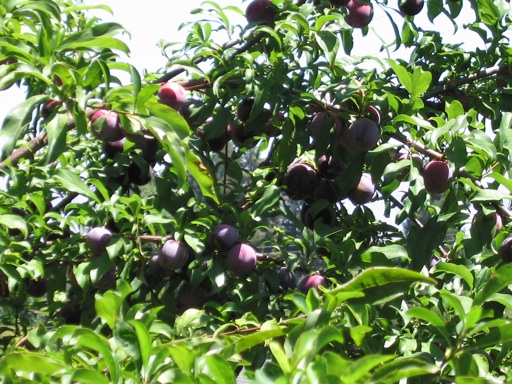
This is a picture of a Santa Rosa Plum tree growing in my parents’ yard. It is full of plums this year, much more than it usually has. Temperate climate fruit trees like plums need a lot of winter chill hours (hours below 45 degrees) to bloom and set fruit. I think part of the reason this tree is producing so heavily is that last winter was colder than normal – at least in terms of night time low temperatures.
In addition, 2008 was a very dry spring in California. It was one of the driest springs on record. Heavy spring rains can reduce fruit production by damaging the blossoms or preventing them from getting pollinated. The dry weather has probably increased fruit tree production this year.
2008 has also been a bountiful year for fruit trees in my yard too. My peach, pear, nectarine, apricot, and apple trees are full of fruit. I don’t have a plum tree right now. In general, plums are not at the top of my list of favorite fruits, but Santa Rosa plums do have a nice sweet-tart flavor. They are mainly fresh eating plums, because the fruit flesh clings tightly to the seed (clingstone), making it hard to cut out for cooking. I would recommend them to anyone considering planting a fruit tree in their yard. One nice thing about plums is that they tend produce fruit at a younger age than other fruit trees, such as pears.
August 10 2008 | Plums | Comments Off on Santa Rosa Plums

















